DODGE DURANGO 2021 Vehicle Warranty
Manufacturer: DODGE, Model Year: 2021, Model line: DURANGO, Model: DODGE DURANGO 2021Pages: 262, PDF Size: 10.42 MB
Page 221 of 262
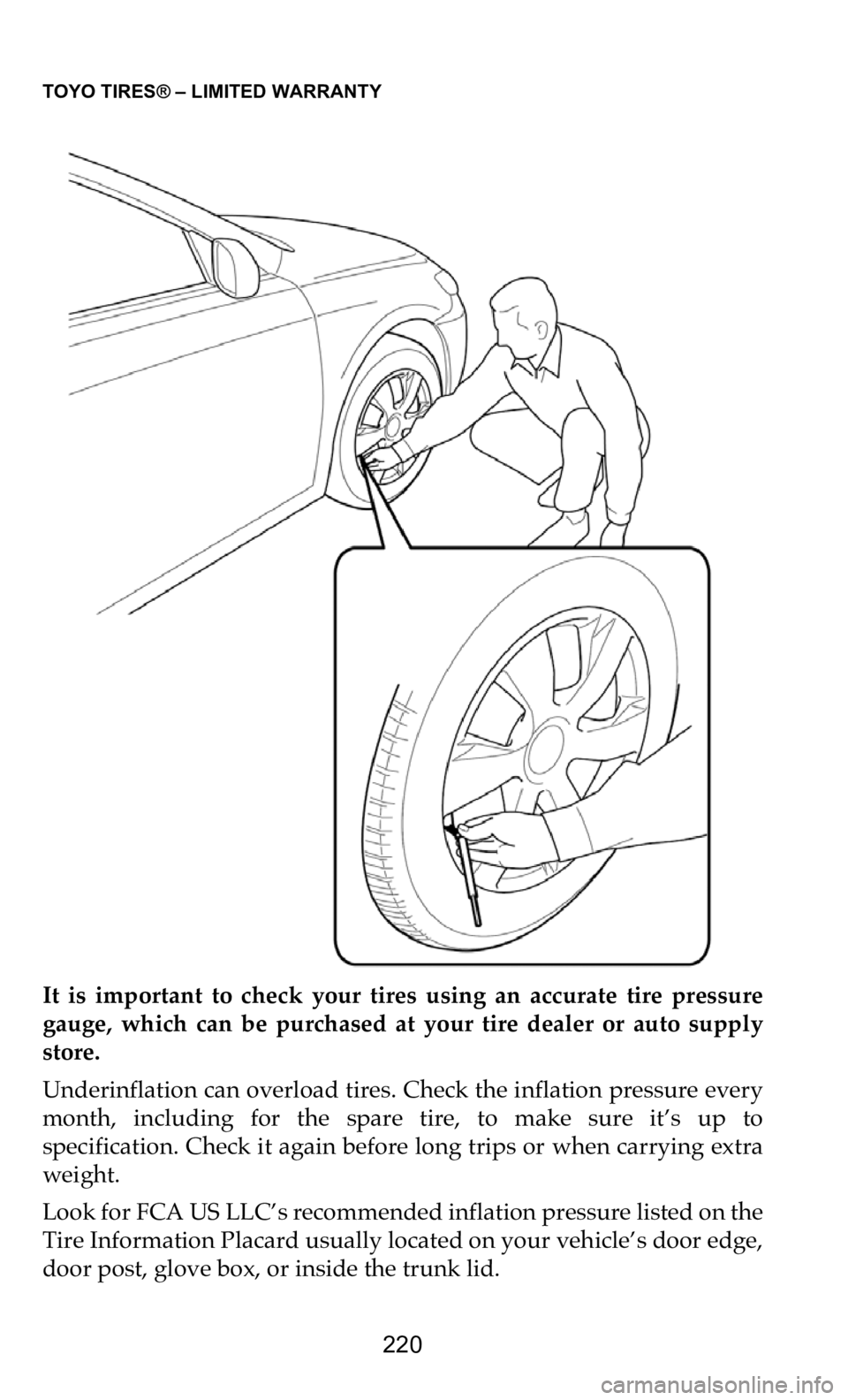
TOYO TIRES® – LIMITED WARRANTY
220
It is important to check your tires using an accurate tire pressure
gauge, which can be purchased at your tire dealer or auto supply
store.
Underinflation can overload tires. Check the inflation pressure every
mo
nth, including for the spare tire, to make sure it’s up to
specification. Check it again before long trips or when carrying extra
weight.
Look for FCA US LLC’s recommended inflation pressure listed on the
Ti
re Information Placard usually located on your vehicle’s door edge,
door post, glove box, or inside the trunk lid.
Page 222 of 262

TOYO TIRES® – LIMITED WARRANTY
221
CAUTION!
The inflation pressure shown on the sidewall of the tire is not the
in
tended inflation pressure for the vehicle. Always refer to the
vehicle’s Tire Information Placard.
WARNING!
Driving on tires with insufficient inflation pressure is dangerous
be
cause it will cause your tires to overheat. This can cause sudden
tire failure, which may result in loss of vehicle control and lead to
serious personal injury or death.
Page 223 of 262
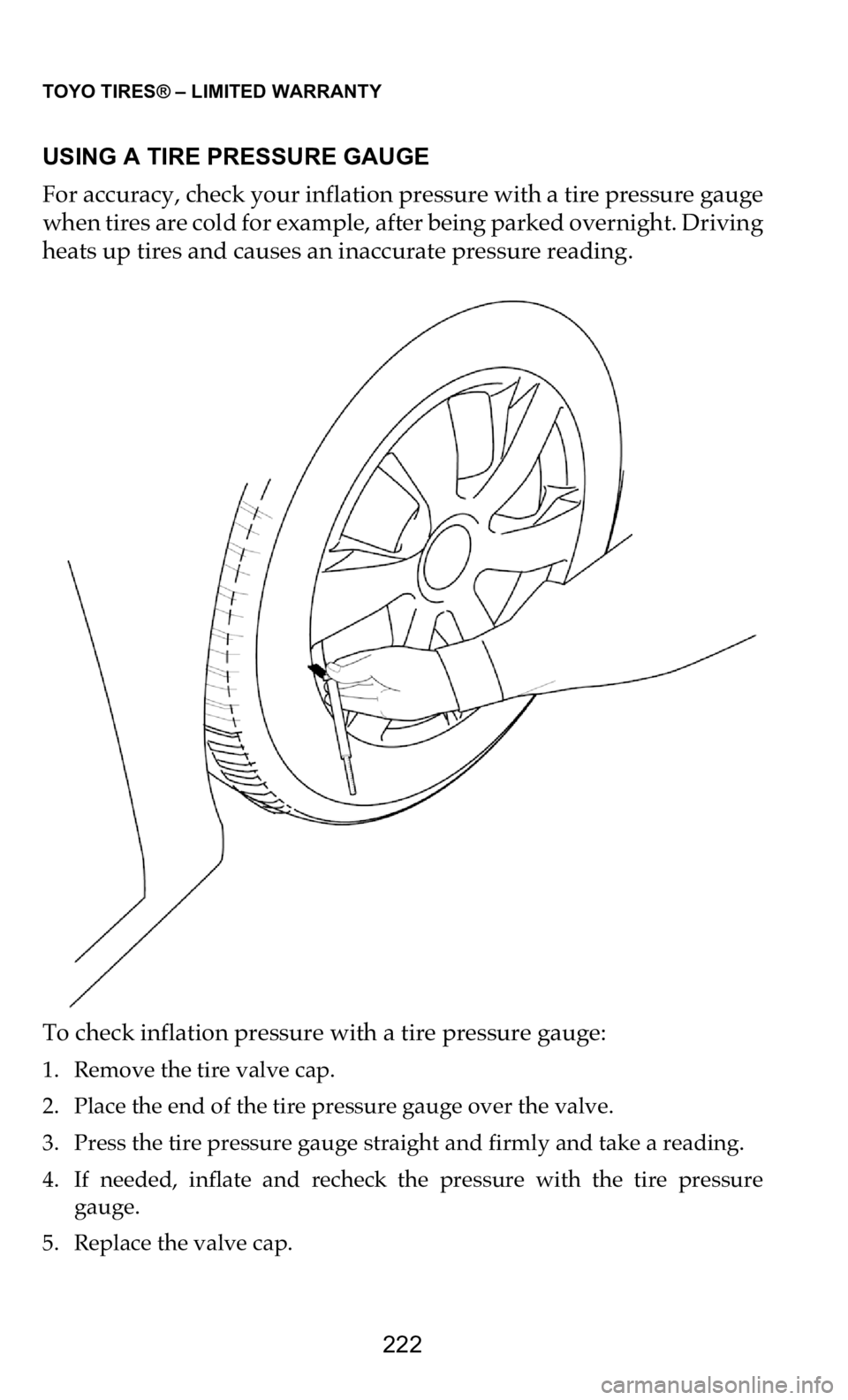
TOYO TIRES® – LIMITED WARRANTY
222
USING A TIRE PRESSURE GAUGE
For accuracy, check your inflation pressure with a tire pressure gauge
wh
en tires are cold for example, after being parked overnight. Driving
heats up tires and causes an inaccurate pressure reading.
To check inflation pressure with a tire pressure gauge:
1. Remove the tire valve cap.
2. P lace the end of the tire pressure gauge over the valve.
3
. P ress the tire pressure gauge straight and firmly and take a reading.
4
. I f needed, inflate and recheck the pressure with the tire pressure
ga
uge.
5. R eplace the valve cap.
Page 224 of 262
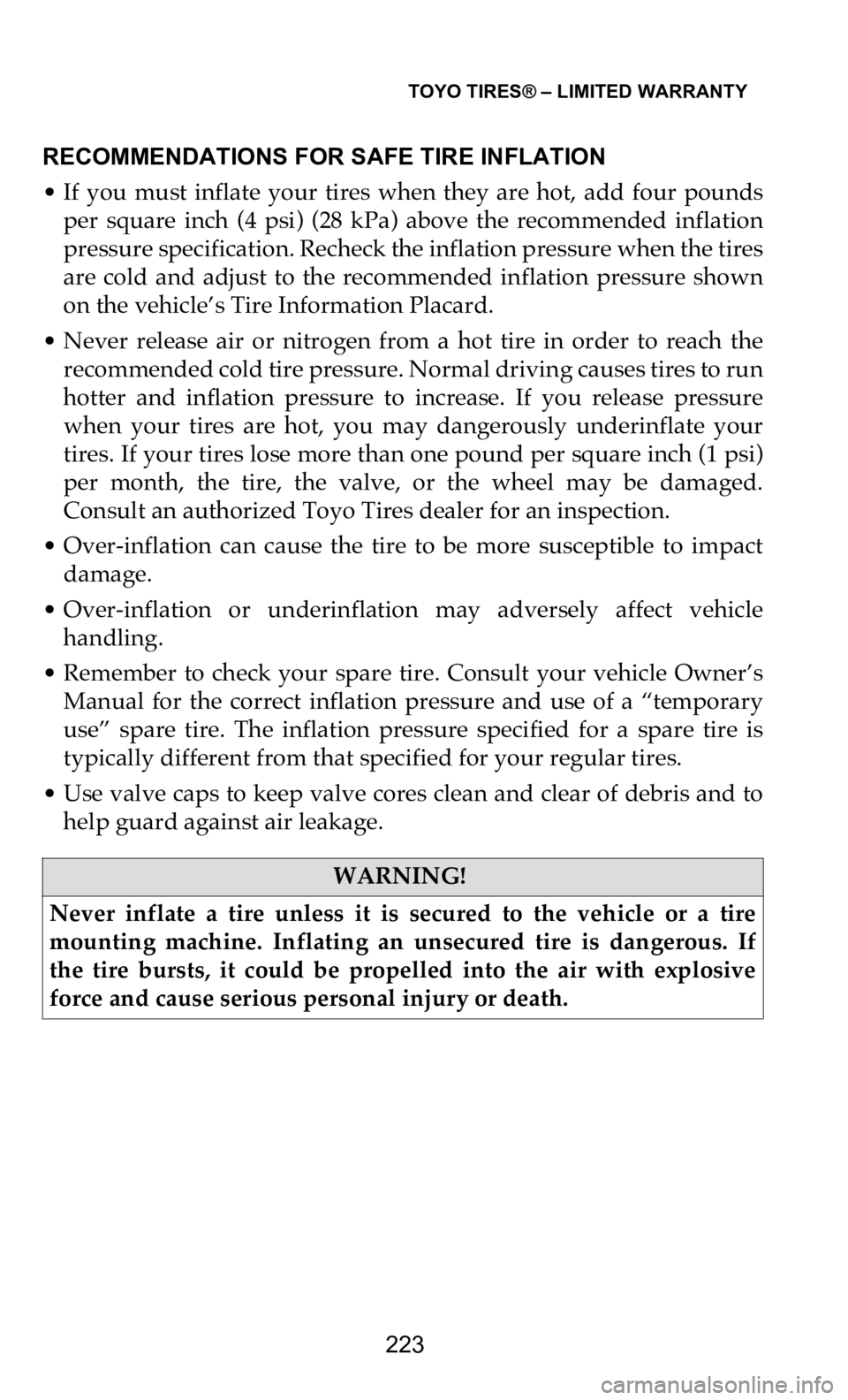
TOYO TIRES® – LIMITED WARRANTY
223
RECOMMENDATIONS FOR SAFE TIRE INFLATION
• If you must inflate your tires when they are hot, add four pounds
p
er square inch (4 psi) (28 kPa) above the recommended inflation
pressure specification. Recheck the inflation pressure when the tires
are cold and adjust to the recommended inflation pressure shown
on the vehicle’s Tire Information Placard.
• Never release air or nitrogen from a hot tire in order to reach the
r
ecommended cold tire pressure. Normal driving causes tires to run
hotter and inflation pressure to increase. If you release pressure
when your tires are hot, you may dangerously underinflate your
tires. If your tires lose more than one pound per square inch (1 psi)
per month, the tire, the valve, or the wheel may be damaged.
Consult an authorized Toyo Tires dealer for an inspection.
• Over-inflation can cause the tire to be more susceptible to impact
d
amage.
• Over-inflation or underinflation may adversely affect vehicle
h
andling.
• Remember to check your spare tire. Consult your vehicle Owner’s
M
anual for the correct inflation pressure and use of a “temporary
use” spare tire. The inflation pressure specified for a spare tire is
typically different from that specified for your regular tires.
• Use valve caps to keep valve cores clean and clear of debris and to
h
elp guard against air leakage.
WARNING!
Never inflate a tire unless it is secured to the vehicle or a tire
mo
unting machine. Inflating an unsecured tire is dangerous. If
the tire bursts, it could be propelled into the air with explosive
force and cause serious personal injury or death.
Page 225 of 262

TOYO TIRES® – LIMITED WARRANTY
224
VEHICLES EQUIPPED WITH TIRE PRESSURE MONITORING
SYSTEMS (TPMS)Even if your vehicle is equipped with a tire pressure
monitoring system, you should check your tire pressure
at
least once per month when the tires are cold for
example, after being parked overnight. Tire pressure
warning systems are not a substitute for regular tire
pressure maintenance.
IDENTIFYING DAMAGED TIRES
• I f your tire strikes a road hazard at any speed, internal tire damage
c
ould result, which may lead to sudden tire failure and loss of
vehicle control. Tire failure may even occur miles after the initial
impact. Impact damage from such hazards may not be visible on the
outside of the tire. Have your Toyo Tires® dealer dismount the tire
and inspect it for damage. A tire may not have visible signs of
damage on the tire surface or the interior.
• If the impact was sufficient to bend the wheel flange, internal tire
d
amage may have occurred, compromising the safety and integrity
of the tire. Such impact damage may result in a sudden tire failure
many weeks or months later. Tire replacement is highly recom -
mended as a safety precaution.
• Indications of impact damage include, but are not limited to, a
b
ubble or a blister on the outside of the tire.
• Have your dealer inspect your tires if you see anything unusual or
i
f cuts, cracks, splitting, or bruises in the tread and sidewall areas are
visible. Bumps or bulges may indicate a serious and dangerous
separation within the tire body. Have your tire inspected by a qual -
ified tire service person. It may be necessary to have the tire
re
moved from the wheel for a complete inspection.
WARNING!
If your vehicle is equipped with TPMS, read the vehicle Owner’s
Ma
nual regarding its operation. Some TPMS systems do not alert
you until the tires are significantly underinflated, which could
result in permanent tire damage and possible sudden tire failure.
In the event that your TPMS malfunction indicator lamp is
displayed, you should immediately pull over to a safe parking
area and check your tires.
Page 226 of 262
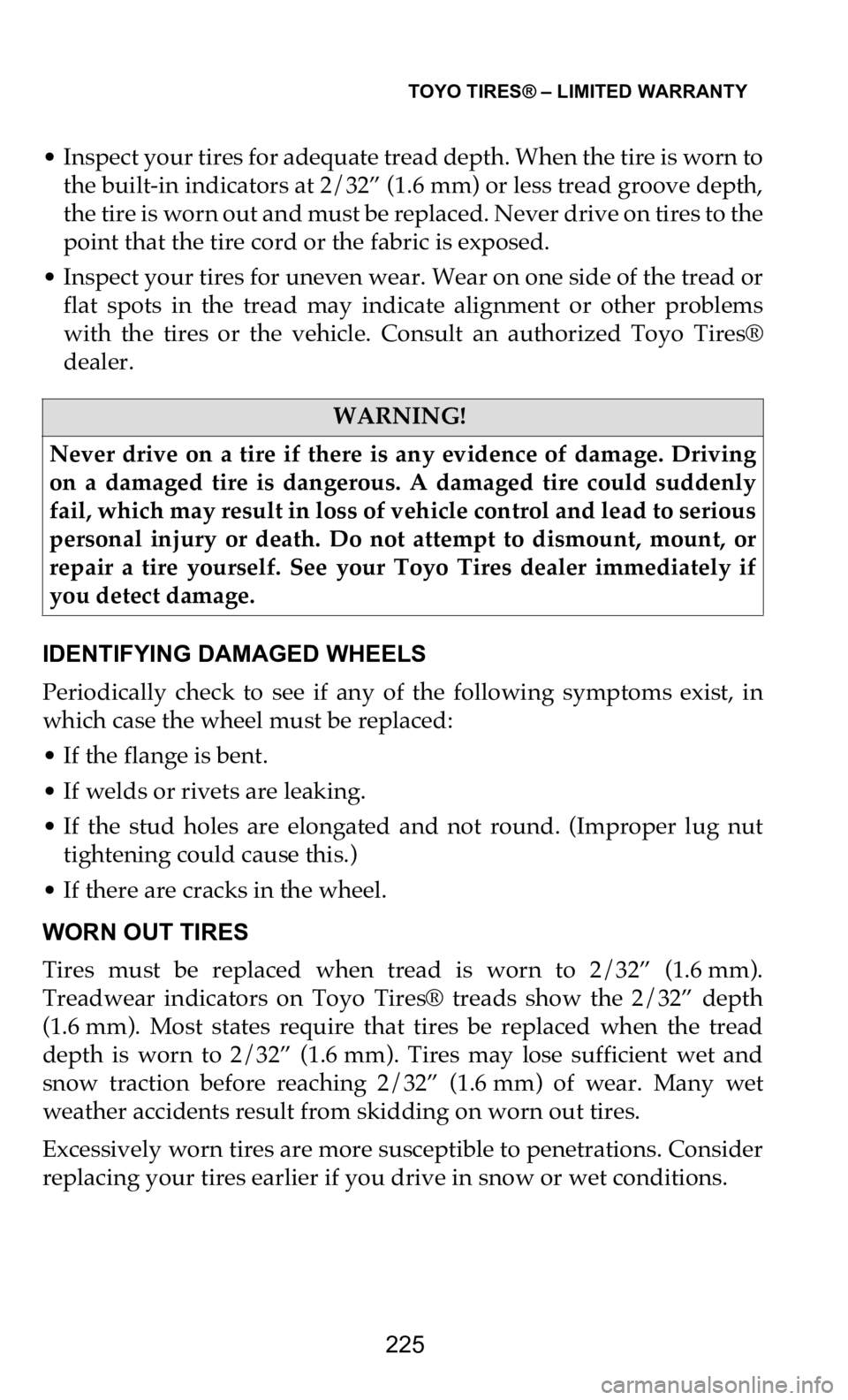
TOYO TIRES® – LIMITED WARRANTY
225
• Inspect your tires for adequate tread depth. When the tire is worn to
the built-in indicators at 2/32” (1.6 mm) or less tread groove depth,
th
e tire is worn out and must be replaced. Never drive on tires to the
point that the tire cord or the fabric is exposed.
• Inspect your tires for uneven wear. Wear on one side of the tread or
f
lat spots in the tread may indicate alignment or other problems
with the tires or the vehicle. Consult an authorized Toyo Tires®
dealer.
IDENTIFYING DAMAGED WHEELS
Periodically check to see if any of the following symptoms exist, in
w h
ich case the wheel must be replaced:
• If the flange is bent.
•
If welds or rivets are leaking.
•
If the stud holes are elongated and not round. (Improper lug nut
t
ightening could cause this.)
• If there are cracks in the wheel.
W
ORN OUT TIRES
Tires must be replaced when tread is worn to 2/32” (1.6 mm).
Tr
eadwear indicators on Toyo Tires® treads show the 2/32” depth
(1.6 mm). Most states require that tires be replaced when the tread
de
pth is worn to 2/32” (1.6 mm). Tires may lose sufficient wet and
sn
ow traction before reaching 2/32” (1.6 mm) of wear. Many wet
we
ather accidents result from skidding on worn out tires.
Excessively worn tires are more susceptible to penetrations. Consider
re
placing your tires earlier if you drive in snow or wet conditions.
WARNING!
Never drive on a tire if there is any evidence of damage. Driving
on
a damaged tire is dangerous. A damaged tire could suddenly
fail, which may result in loss of vehicle control and lead to serious
personal injury or death. Do not attempt to dismount, mount, or
repair a tire yourself. See your Toyo Tires dealer immediately if
you detect damage.
Page 227 of 262
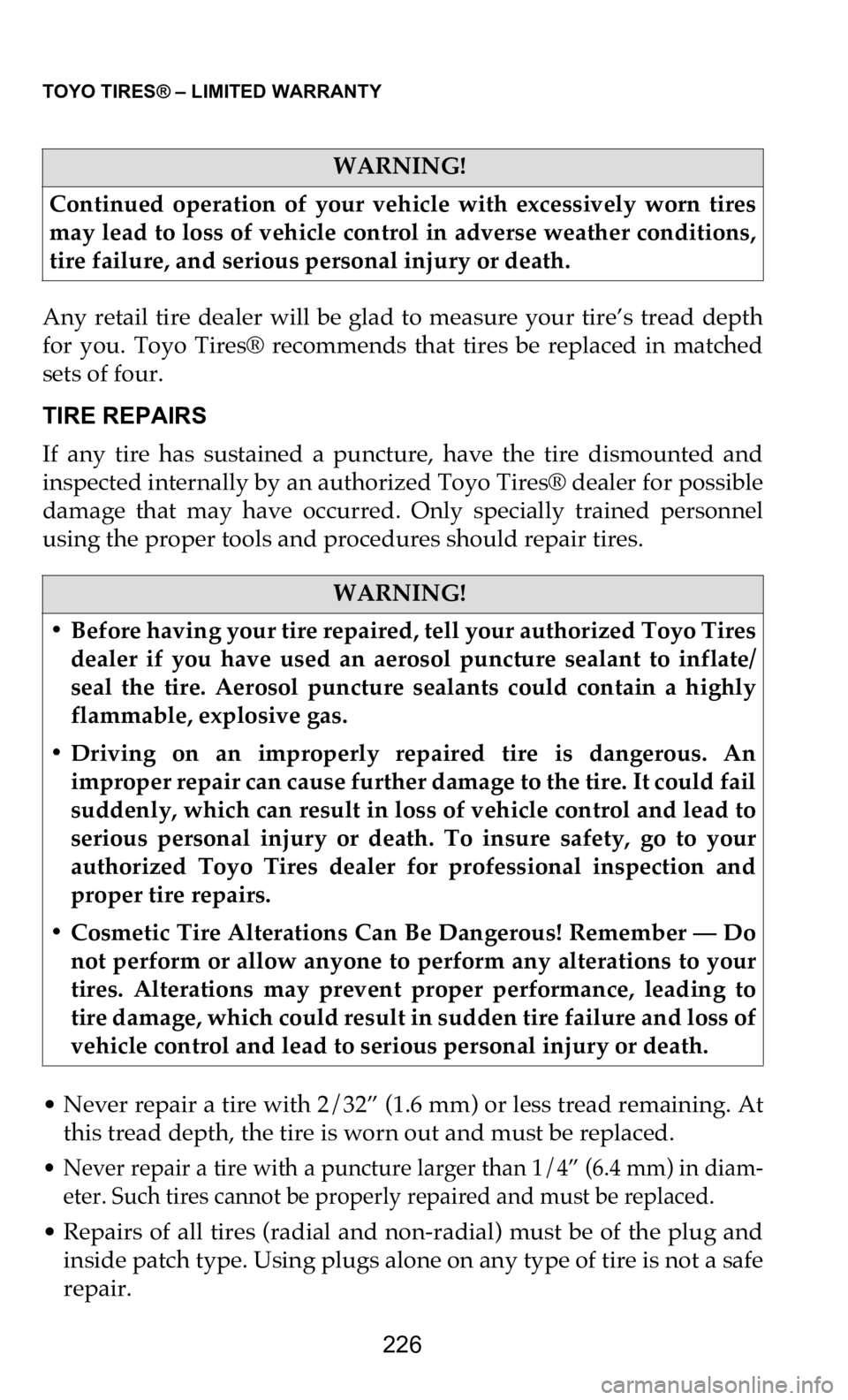
TOYO TIRES® – LIMITED WARRANTY
226
Any retail tire dealer will be glad to measure your tire’s tread depth
for you. Toyo Tires® recommends that tires be replaced in matched
sets of four.
TIRE REPAIRS
If any tire has sustained a puncture, have the tire dismounted and
in
spected internally by an authorized Toyo Tires® dealer for possible
damage that may have occurred. Only specially trained personnel
using the proper tools and procedures should repair tires.
• N ever repair a tire with 2/32” (1.6
mm) or less tread remaining. At
th
is tread depth, the tire is worn out and must be replaced.
• Never repair a tire with a puncture larger than 1/4” (6.4
mm) in diam-
eter. Such tires cannot be properly repaired and must be replaced.
• Repairs of all tires (radial and non-radial) must be of the plug and
i
nside patch type. Using plugs alone on any type of tire is not a safe
repair.
WARNING!
Continued operation of your vehicle with excessively worn tires
ma
y lead to loss of vehicle control in adverse weather conditions,
tire failure, and serious personal injury or death.
WARNING!
• Before having your tire repaired, tell your authorized Toyo Tires
d
ealer if you have used an aerosol puncture sealant to inflate/
seal the tire. Aerosol puncture sealants could contain a highly
flammable, explosive gas.
• Driving on an improperly repaired tire is dangerous. An
i
mproper repair can cause further damage to the tire. It could fail
suddenly, which can result in loss of vehicle control and lead to
serious personal injury or death. To insure safety, go to your
authorized Toyo Tires dealer for professional inspection and
proper tire repairs.
• Cosmetic Tire Alterations Can Be Dangerous! Remember — Do
n
ot perform or allow anyone to perform any alterations to your
tires. Alterations may prevent proper performance, leading to
tire damage, which could result in sudden tire failure and loss of
vehicle control and lead to serious personal injury or death.
Page 228 of 262
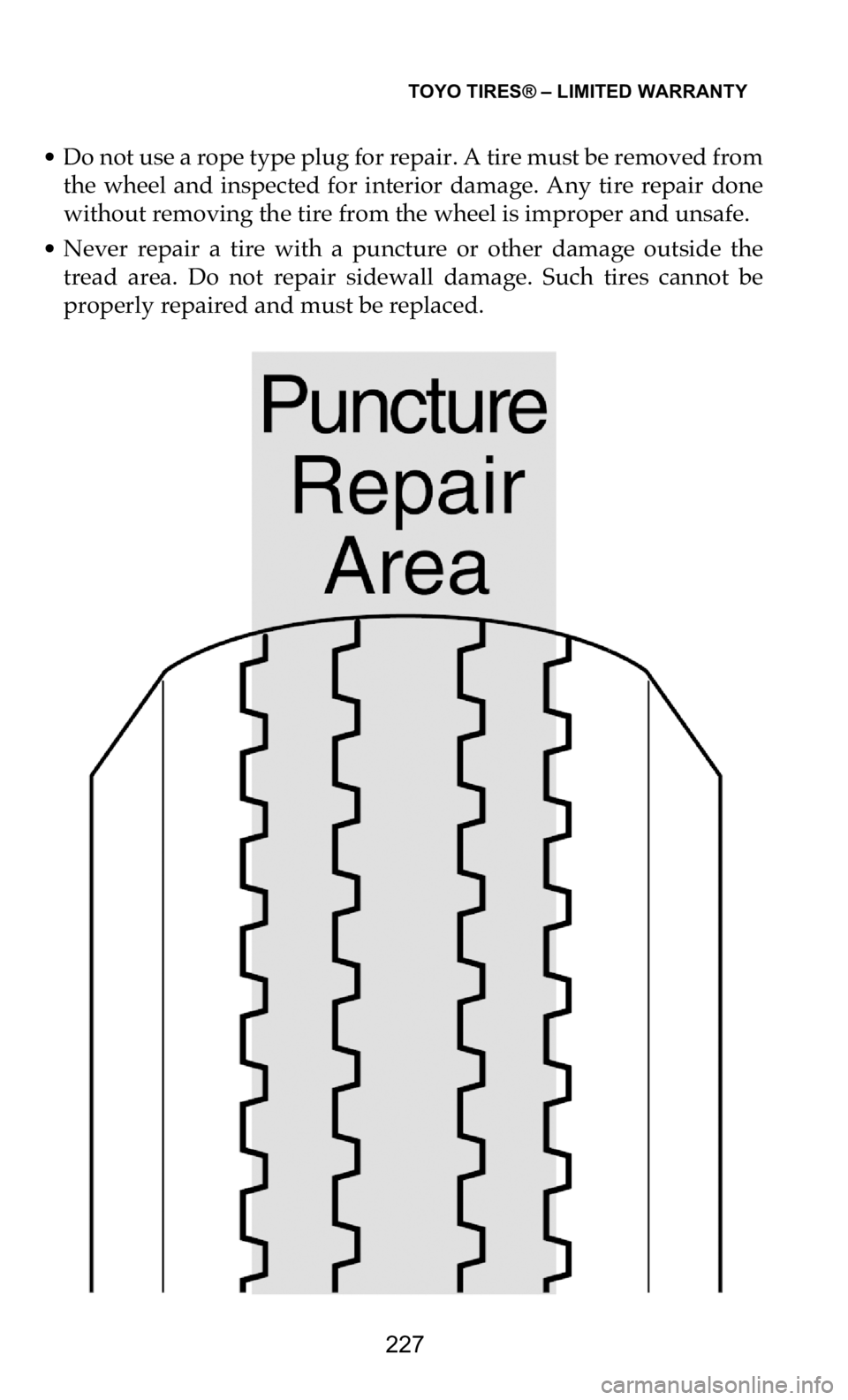
TOYO TIRES® – LIMITED WARRANTY
227
• Do not use a rope type plug for repair. A tire must be removed from
the wheel and inspected for interior damage. Any tire repair done
without removing the tire from the wheel is improper and unsafe.
• Never repair a tire with a puncture or other damage outside the
t
read area. Do not repair sidewall damage. Such tires cannot be
properly repaired and must be replaced.
Page 229 of 262

TOYO TIRES® – LIMITED WARRANTY
228
Toyo Tires speed-rated passenger car tires may be repaired and
returned to service under the following conditions:
• Proper repair materials and procedures have been used.
•
The damage or puncture is not larger than 1/4” (6.4
mm) in diam-
eter.
• The repair will be the first repair performed on that tire. (Only one
r
epair per tire is permitted in order to maintain a limited speed
rating.)
• The tire must have more than 2/32” (1.6
mm) of tread remaining.
Toyo Tires speed-rated passenger tires that have been properly
re
paired qualify for reduced speed ratings as follows:
The maximum speed of a vehicle is limited by the lowest-speed- rated
ti
re on the car.
PROPER SELECTION OF TIRES
When tires need to be replaced, do not guess what tire is right for your
v e
hicle. First look at the vehicle Owner’s Manual or the Tire
Information Placard. They tell you the size of the tires that were on the
vehicle as original equipment.
Replacement tires for any vehicle must be of a size, load range, and
lo
ad capacity (by inflation) that is capable of supporting the same load
as the vehicle’s Original Equipment (OE) installed tires. Avoid
installing used tires on a vehicle. There is no way to determine what
road hazards or abuse a previously owned tire may have incurred.
ORIGINAL SPEED RATING AFTER PUNCTURE REPAIR
(Y), Y, W, Z, V, VR, H H (maximum speed 130 mph)
T T
S S
CAUTION!
A tire’s speed rating is void if the tire has been retreaded,
da
maged, abused, or otherwise altered from its original condition.
Thereafter, it should be treated as a non-speed-rated tire. In
addition, retreaded passenger and light truck tires are not
warranted by Toyo Tires for any reason. Toyo Tires speed ratings
are voided for retreaded tires.
Page 230 of 262
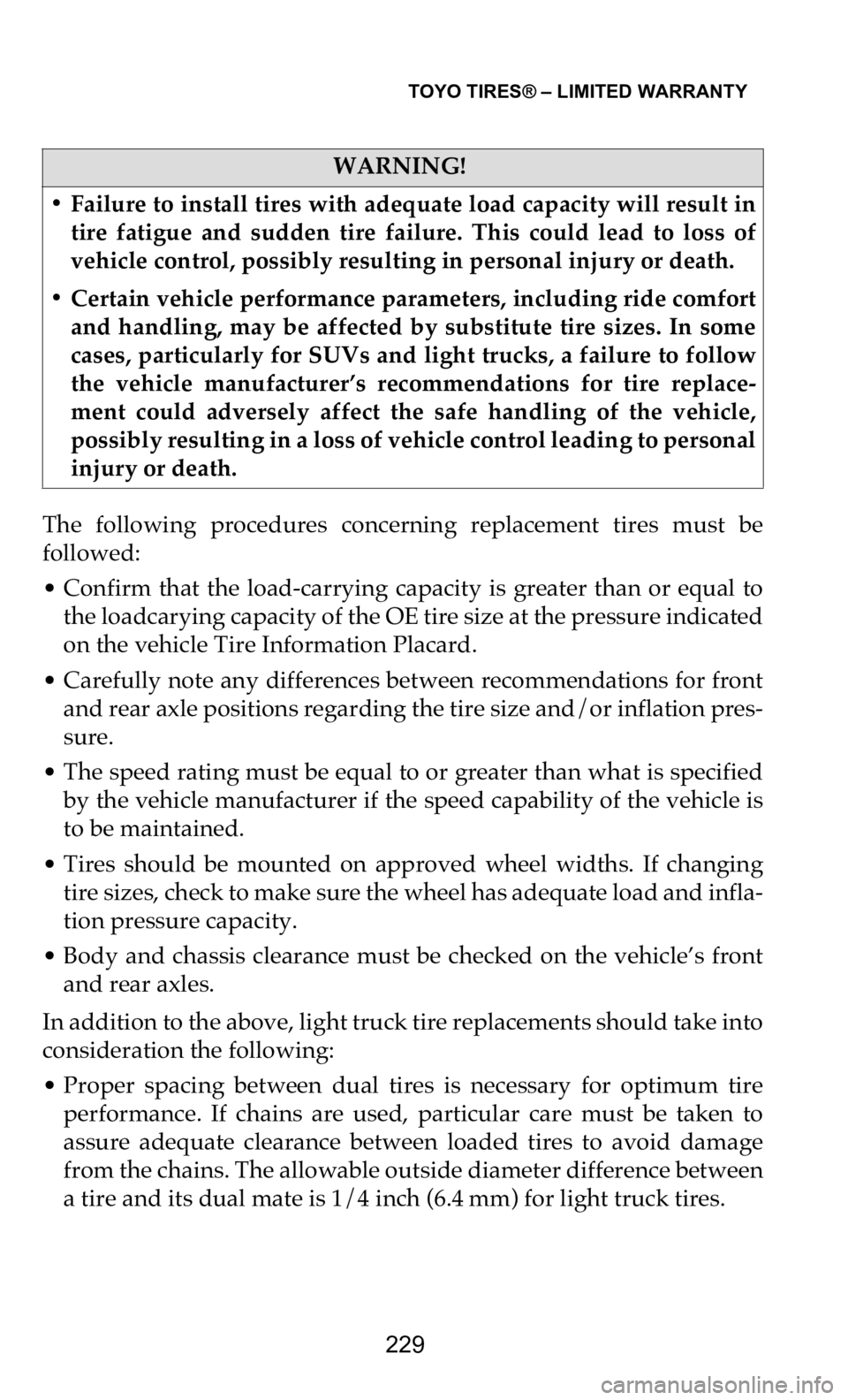
TOYO TIRES® – LIMITED WARRANTY
229
The following procedures concerning replacement tires must be
followed:
• Confirm that the load-carrying capacity is greater than or equal to
t
he loadcarying capacity of the OE tire size at the pressure indicated
on the vehicle Tire Information Placard.
• Carefully note any differences between recommendations for front
a
nd rear axle positions regarding the tire size and/or inflation pres-
sure.
• The speed rating must be equal to or greater than what is specified
b
y the vehicle manufacturer if the speed capability of the vehicle is
to be maintained.
• Tires should be mounted on approved wheel widths. If changing
t
ire sizes, check to make sure the wheel has adequate load and infla -
tion pressure capacity.
• Body and chassis clearance must be checked on the vehicle’s front
a
nd rear axles.
In addition to the above, light truck tire replacements should take into
co
nsideration the following:
• Proper spacing between dual tires is necessary for optimum tire
p
erformance. If chains are used, particular care must be taken to
assure adequate clearance between loaded tires to avoid damage
from the chains. The allowable outside diameter difference between
a tire and its dual mate is 1/4 inch (6.4 mm) for light truck tires.
WARNING!
• Failure to install tires with adequate load capacity will result in
t
ire fatigue and sudden tire failure. This could lead to loss of
vehicle control, possibly resulting in personal injury or death.
• Certain vehicle performance parameters, including ride comfort
a
nd handling, may be affected by substitute tire sizes. In some
cases, particularly for SUVs and light trucks, a failure to follow
the vehicle manufacturer’s recommendations for tire replace -
ment could adversely affect the safe handling of the vehicle,
po
ssibly resulting in a loss of vehicle control leading to personal
injury or death.